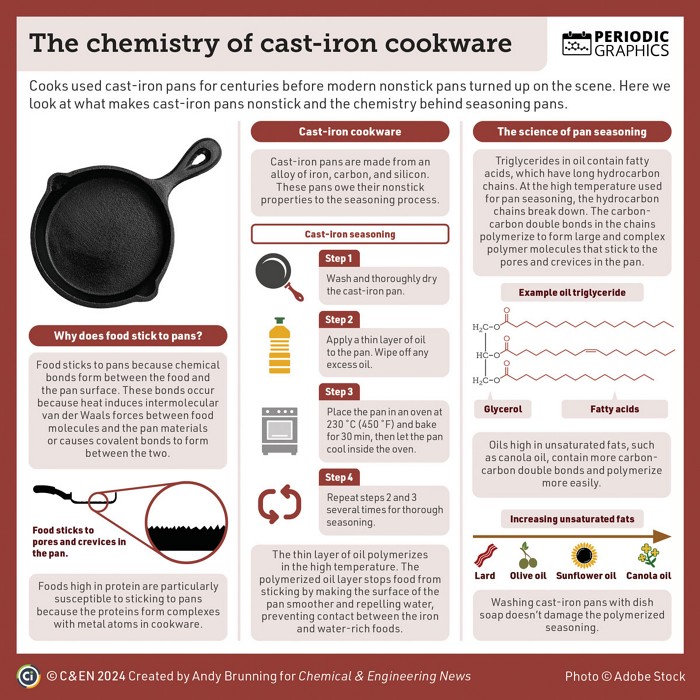Advertisement
Grab your lab coat. Let's get started
Welcome!
Welcome!
Create an account below to get 6 C&EN articles per month, receive newsletters and more - all free.
It seems this is your first time logging in online. Please enter the following information to continue.
As an ACS member you automatically get access to this site. All we need is few more details to create your reading experience.
Not you? Sign in with a different account.
Not you? Sign in with a different account.
ERROR 1
ERROR 1
ERROR 2
ERROR 2
ERROR 2
ERROR 2
ERROR 2
Password and Confirm password must match.
If you have an ACS member number, please enter it here so we can link this account to your membership. (optional)
ERROR 2
ACS values your privacy. By submitting your information, you are gaining access to C&EN and subscribing to our weekly newsletter. We use the information you provide to make your reading experience better, and we will never sell your data to third party members.
Food Science
Newscripts
Something brewing
by Laurel Oldach
February 3, 2024
| A version of this story appeared in
Volume 102, Issue 4
Tea leaf reading

Michelle Francl has always been a tea drinker. But her scientific interest began brewing in 2020 on #ChemTwitter when @andrechemist posted a musing: Are tetrahedral tea bags really any better?
Francl, a professor at Bryn Mawr College who moonlights as a columnist forNature Chemistry, was always on the lookout for subjects to write about. Besides, she says, her grading was done for the semester. Four years and countless cups later, she has launched the end result, Steeped: The Chemistry of Tea.
Francl’s background as a professional explainer of all things chemical is clear from the book’s opening, a lively explanation of the fundamentals of chemistry. The story then romps from plantation to mug to creamer, presenting plenty of structures and tea trivia along the way.
Readers may be surprised to learn that green, black, and oolong teas—along with three more-obscure varieties—all come from the same plant, Camellia sinensis, and differ mostly in processing. Many will not have considered that caffeine serves the plant as a pesticide, contemplated the reactions that can cause a film to form on microwaved tea, or thought about how globular casein proteins in milk react with tea’s antioxidants.
Besides reading widely on tea chemistry, Francl researched the book by conducting some experiments of her own. She sipped deuterated water and L-theanine-spiked infusions to determine whether she could taste any difference. She tested vodka decaffeination of loose tea leaves: “It tastes terrible. Ten out of ten, would not recommend,” she says.
She also charted a cooling curve after pouring hot water into an iron teapot. “I assign problems like that all the time when I teach p-chem,” Francl tells Newscripts, adding that one semester, in the thick of book writing, she gave a midterm entirely composed of tea-related questions.
Francl’s own tea-making practices have changed a little based on all she’s learned. These days, she prewarms her teapot and cup, especially on chilly winter mornings. And now that she’s better acquainted with the soothing volatiles in the warm vapor over a hot cup, she’s more likely to keep the lid off her mug when she goes to a stressful faculty meeting. But there are other lessons she ignores; for example, she still reheats her tea in the microwave despite having learned exactly how it causes a film of carbonate compounds to coalesce.
And about those tetrahedral tea bags? They have greater surface area and give the leaves more space to swell, all of which is good for the brew. But beware: some are made from nylon and might shed microplastics.
Tempest over a tea recipe

A book’s launch day is always exciting for an author, but Steeped brought an unanticipated degree of drama after author Michelle Francl told the Guardian her recipe for the perfect cup of tea during a publicity interview. She often includes a dash of table salt because research suggests that sodium cations suppress the taste perception of bitterness.
Amidst some public saltiness over the suggestion, the US embassy in the UK posted a press release to its social media accounts. The diplomats wished to assure readers that “adding salt to Britain’s national drink is not official United States policy.” They closed with a cheeky commitment “to make tea in the proper way—by microwaving it.”
“Who could have guessed my book about tea would brew up such a storm the US Embassy needed to step in?” Francl writes to Newscripts, adding, “Go ahead and make that tea in the microwave and see.”
Please send comments and suggestions to newscripts@acs.org.




Join the conversation
Contact the reporter
Submit a Letter to the Editor for publication
Engage with us on Twitter